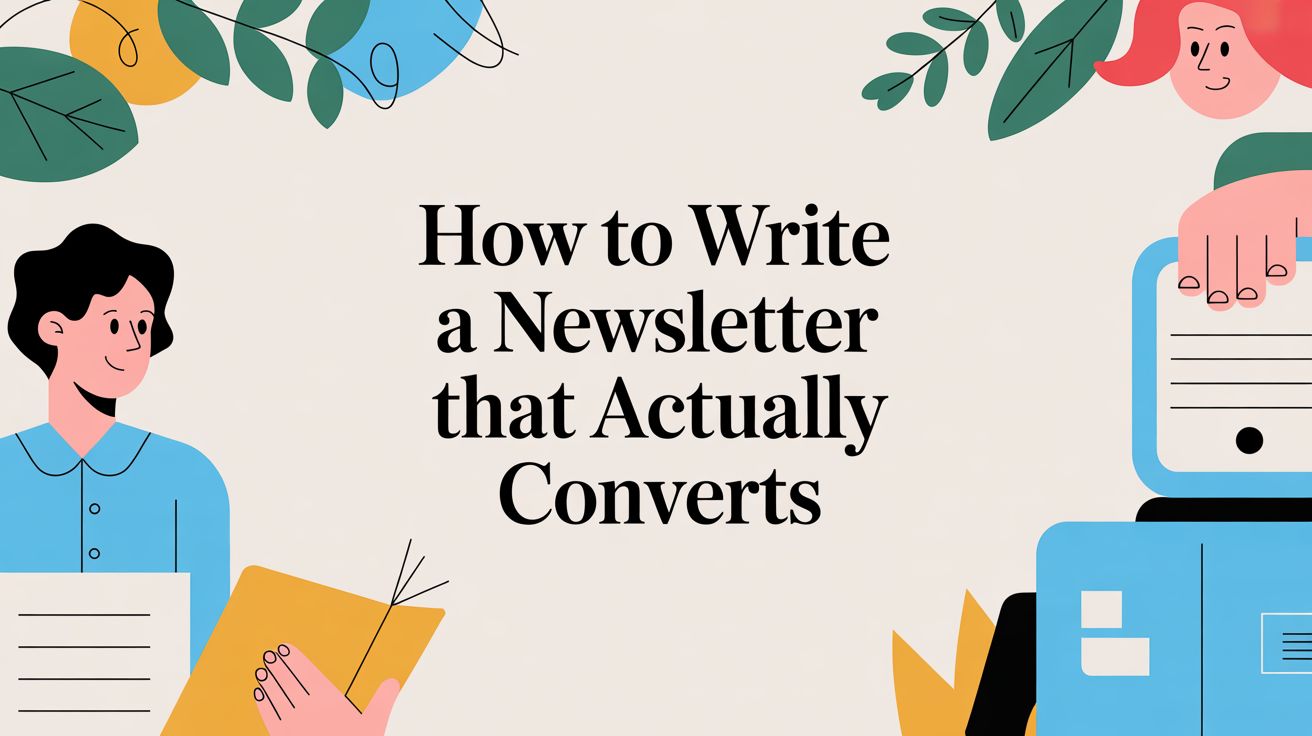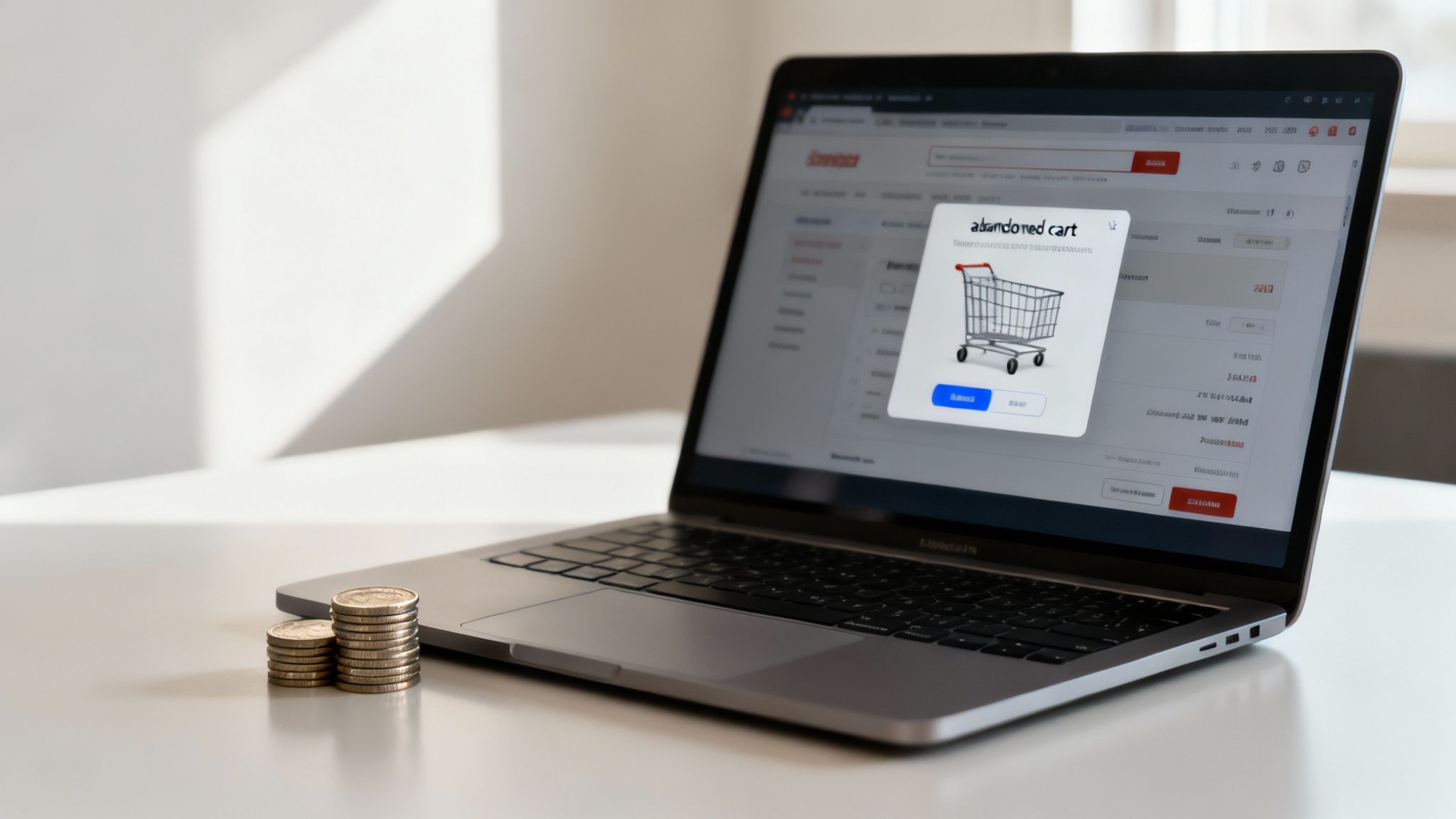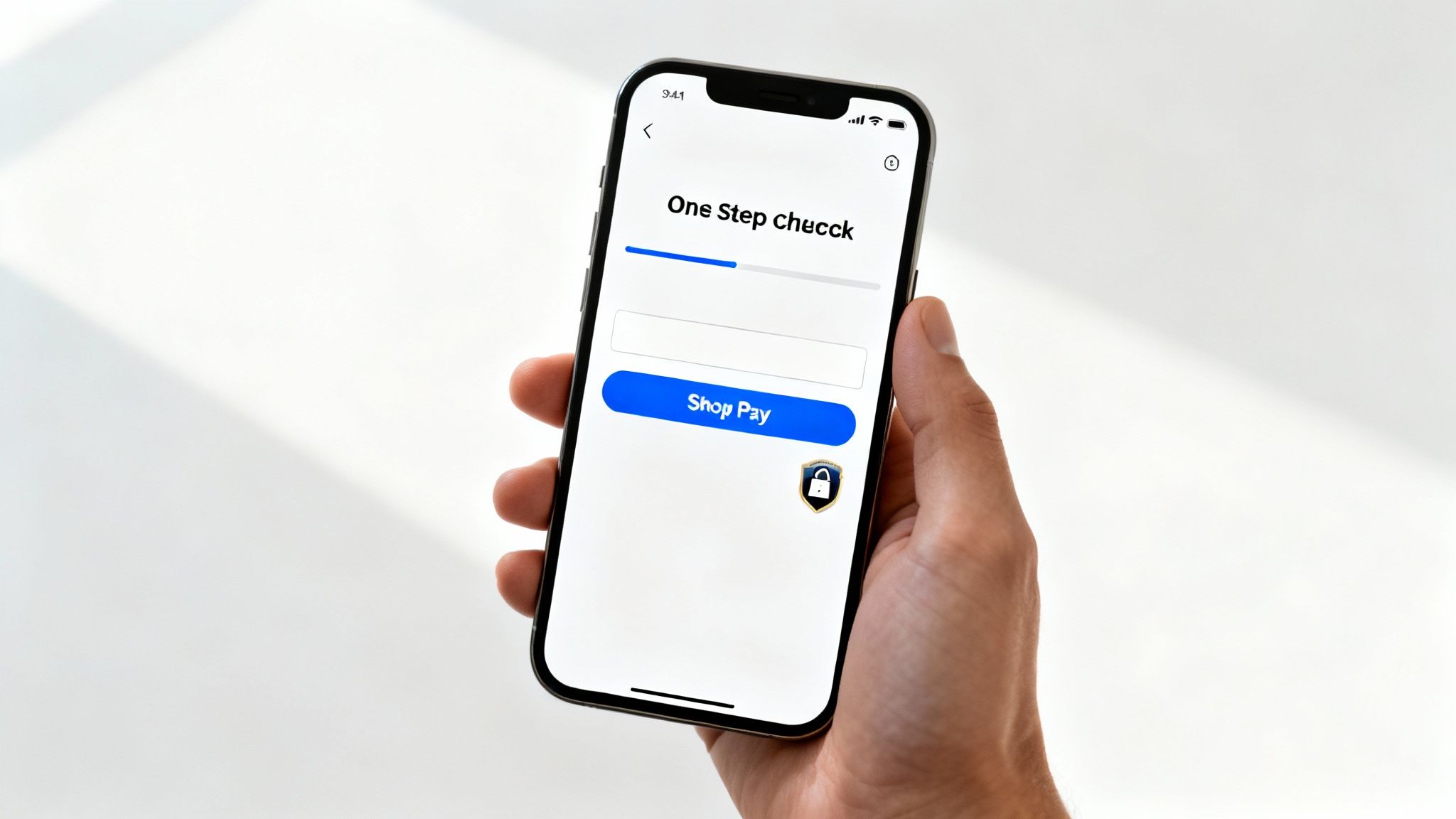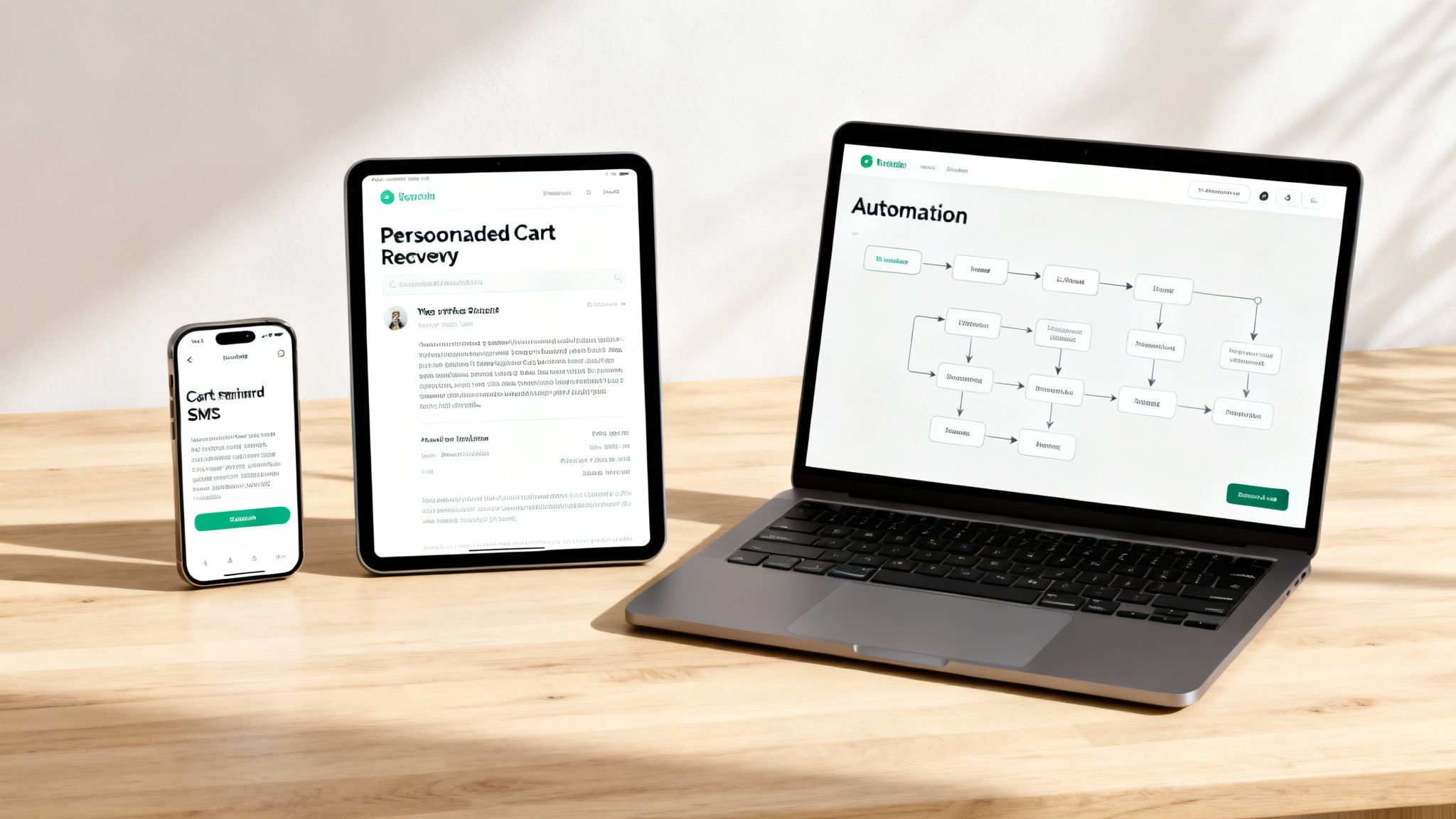
How to Reduce Shopping Cart Abandonment: 7 Proven Tactics to Reclaim Lost Revenue

That moment a shopper adds an item to their cart is a win. But when you see that the industry average cart abandonment rate is nearly 70%, you realize most of those wins are slipping away. It’s not just a metric; it's a critical breakdown in your revenue pipeline right at the finish line.
So, how do you fix it? The approach is threefold: ruthlessly optimize the checkout journey to eliminate friction, ethically apply behavioral psychology like urgency to motivate immediate action, and deploy an automated recovery system to win back shoppers who hesitate.
This isn't about plugging a small leak. It's about turning your single largest source of lost revenue into your biggest growth opportunity, directly impacting your ROI and protecting your profit margins.
Why Shoppers Abandon Carts and How to Win Them Back

Shopping cart abandonment is one of the most significant challenges in ecommerce. The industry average hovers around a staggering 70%, meaning the vast majority of your potential sales simply evaporate.
This isn't just a lost transaction. It's lost profit from high-intent customers who were seconds away from clicking "buy." The financial impact is massive, with estimates suggesting over $260 billion in recoverable orders in the US and EU alone could be saved through better checkout design and psychological triggers.
This guide provides a framework to reclaim that lost revenue. We're going beyond basic fixes to address the real psychological and logistical hurdles that cause shoppers to hesitate, leveraging the science of consumer behavior to drive conversions.
The Psychology Behind the Abandoned Cart
At its core, cart abandonment is a decision driven by friction, anxiety, or a simple lack of motivation. Consumer psychology and behavioral economics research show that even tiny obstacles can completely derail a purchase. The decision to abandon often boils down to a few key psychological drivers:
- Decision Fatigue: When your checkout has too many steps or asks for too much information, it becomes overwhelming. Behavioral science shows that an excess of choices leads to inaction. Abandoning the cart suddenly feels like the easier, less stressful choice.
- Cost Anxiety: We've all been there. You get to the final step and suddenly see unexpected shipping fees or taxes. This feels like a bait-and-switch, triggering a powerful negative emotional response known as "cost anxiety" that kills the sale.
- Lack of Trust: If your site looks dated, your return policy is buried, or your payment security isn't obvious, you create doubt. Shoppers will hesitate and look for a more trustworthy alternative.
- Absence of Urgency: Without a clear reason to buy right now, the cart becomes a glorified "wish list." Principles like Fear of Missing Out (FOMO) and scarcity are not activated, so shoppers intend to come back later, but life gets in the way, and they rarely do.
Actionable Takeaway: Think of every abandoned cart not as a failure, but as direct feedback on friction points. It's a customer telling you exactly where the leaks are in your revenue pipeline. Your job is to make completing the purchase the path of least resistance.
To effectively reduce shopping cart abandonment, your strategy needs to address these issues head-on. It's about refining the user experience while intelligently weaving in proven consumer psychology principles.
Your Cart Abandonment Recovery Framework
| Strategy Area | Primary Goal | Key Tactics | Business Impact |
|---|---|---|---|
| Checkout Experience | Eliminate friction and build trust | Guest checkout, minimal form fields, progress bars | Increase conversion rate, reduce customer acquisition cost |
| Psychological Triggers | Create motivation for immediate action | Scarcity alerts, social proof notifications, time-sensitive offers | Boost revenue, protect profit margins by avoiding discounts |
| Cost Transparency | Prevent last-minute surprises | Upfront shipping costs, free shipping thresholds, tax estimators | Increase Average Order Value (AOV), improve customer trust |
| Automated Recovery | Re-engage and convert hesitant shoppers | Abandoned cart emails, SMS reminders, exit-intent offers | Recover lost sales, maximize ROI on marketing efforts |
By focusing on these four key areas, you can build a comprehensive system that not only prevents abandonment but actively recovers sales that would have otherwise been lost for good.
Streamline Your Checkout to Eliminate Purchase Friction

The checkout is the finish line—the critical moment where a browser becomes a customer. It’s also where an astonishing number of sales vanish due to unnecessary friction. Every extra field, unexpected step, and confusing instruction is another reason to leave.
The average ecommerce checkout still has 5.1 steps from adding an item to the cart to completing the order. This complexity is a huge hurdle, especially on mobile, where abandonment rates can shoot past 80%. Data shows that between 18% and 22% of shoppers abandon a purchase simply because the process was too long or confusing. This isn't just a user experience issue; it's a direct leak in your revenue pipeline.
Ditch Mandatory Account Creation
Forcing a first-time shopper to create an account before they can buy anything is one of the quickest ways to kill a sale. It feels like a huge commitment and an invasive request for their data, causing up to 26% of shoppers to abandon the purchase.
Actionable Takeaway: Always offer a guest checkout option and make it the most prominent choice. You can still prompt them to create an account after the sale is complete, on the "thank you" page. Frame it as a benefit for them—mention faster checkouts next time and easy order tracking.
By focusing on the immediate sale instead of grabbing data upfront, you remove a major psychological roadblock. The goal is to make that first purchase feel completely effortless. That's what builds the trust needed for a long-term customer relationship.
Radically Simplify Your Forms
Every field on your checkout form is a micro-friction point. Combined, they become a massive barrier to purchase. Only ask for the absolute bare-minimum information needed to process the payment and ship the order.
Actionable Takeaway:
- Combine Fields: Use a single "Full Name" field instead of separate "First Name" and "Last Name" fields.
- Auto-fill Addresses: Use tools like the Google Places API to suggest addresses as the user types.
- Default Shipping to Billing: Use a simple checkbox for "My shipping address is the same as my billing address," and make sure it’s checked by default.
For Shopify merchants, Shop Pay is a game-changer. It securely saves a customer's payment and shipping details, enabling checkout with a single click across the Shopify network. This slashes checkout time and can significantly boost conversion rates compared to a standard guest checkout.
Build Unmistakable Trust at Checkout
The moment a customer pulls out their credit card, their sensitivity to security skyrockets. Even a hint of doubt can make them reconsider the purchase. You must make trust visually obvious.
Actionable Takeaway:
- Display Security Badges: Make sure logos from trusted names like Visa, Mastercard, PayPal, and Shop Pay are front and center. Add SSL security seals to show data is encrypted and safe.
- Use a Progress Bar: A simple visual showing where they are in the process (e.g., Shipping > Payment > Review) manages expectations and reduces anxiety.
- Provide Clear Contact Info: A visible customer support email or phone number is a huge trust signal, showing you're a real business ready to help.
By streamlining your checkout, you're directly tackling the biggest reasons for abandonment and turning a leaky funnel into a powerful conversion machine.
Using Urgency and Scarcity to Nudge Shoppers Into Action
Once your checkout is frictionless, the next step is to actively create motivation. This is where Quikly excels, leveraging the science of urgency marketing. The goal isn't just to make buying easy; it’s about making buying right now feel like the smartest decision, based on proven behavioral psychology.
Effective urgency marketing is far more sophisticated than just adding a countdown timer. It’s about ethically applying psychological principles to overcome natural hesitation. Without a solid reason to act immediately, a shopping cart becomes a "save for later" list—one that's usually forgotten.
The Behavioral Science Behind Urgency
Urgency taps directly into fundamental human psychology. A key principle in behavioral economics is loss aversion, which demonstrates that people are far more motivated by the fear of losing something than by the chance of gaining something of equal value.
When a shopper sees a message like "Only 3 left in stock!" you’re reframing the purchase as a fleeting opportunity they're about to lose. This triggers FOMO (Fear of Missing Out) and can completely change their decision-making process, compelling them to finish the purchase to avoid that feeling of regret.
The most powerful urgency tactics are not about manipulation; they are about aligning with natural consumer behavior. By highlighting genuine limitations on time (urgency) or quantity (scarcity), you give shoppers the final nudge they need to overcome indecision. This protects your bottom line by converting high-intent shoppers without resorting to margin-killing discounts.
Moving Beyond Basic Timers to Smart Behavioral Triggers
Many brands mistake urgency for a generic clock on a page. While a standard countdown timer can create pressure, it often feels artificial. Sophisticated urgency marketing, like the "Moments" created with Quikly, is far more nuanced, deploying the right behavioral trigger at the right time to generate revenue, not just capture emails.
- Scarcity (Limited Quantity):
- Basic Timer App: "Limited stock available!" (Vague and ineffective).
- Advanced Behavioral Trigger: "Only 2 left in Medium" (Specific, credible, and drives immediate action).
- Social Proof (Following the Crowd):
- Basic Popup App: "Popular item!" (Unverifiable and weak).
- Advanced Behavioral Trigger: "15 people have this in their cart right now" (Creates real-time demand and social validation).
- Anticipation & FOMO (Building Excitement):
- Basic Banner: A generic "Sale starts Friday!" banner.
- Advanced Behavioral Trigger: A Quikly campaign where users sign up for a limited-time product drop, building anticipation that guarantees immediate action when the offer goes live.
Unlike basic pop-ups focused on email capture, these advanced triggers are designed purely to drive revenue and enhance the shopper's journey.
Putting It Into Practice on Shopify
Adding these psychological triggers to your Shopify or Shopify Plus store is straightforward with the right tools. Quikly automates these "Moments" so they feel dynamic and authentic across the entire shopper journey.
Actionable Takeaway:
- Product Pages: Use real-time inventory counters ("Only 4 left!") to encourage adding to the cart.
- In-Cart Banners: Display a message like "Items in your cart aren't reserved. Finish your purchase before they're gone!"
- Exit-Intent Popups: Instead of just offering a discount, show how many other people are viewing the same item to trigger social proof-fueled FOMO.
By integrating a platform like Quikly with your email and SMS tools like Klaviyo, you can extend this urgency beyond your website. An abandoned cart email can highlight that an item is now low in stock, creating a powerful, personal reason to return and buy. This automated, multi-channel approach turns urgency from a simple tactic into a core part of your revenue recovery strategy.
Eliminate Surprises with Upfront Cost Transparency
Picture this: you've carefully selected your items and are ready to buy, but at the final step, you're hit with an unexpected shipping fee. That jarring moment of "sticker shock" is the single biggest reason people abandon their carts. It feels deceptive and instantly erodes trust.
The number one culprit behind the industry’s staggering 70% cart abandonment rate isn't a complex checkout flow; it's surprise costs. When a customer sees a final price that doesn't match their expectation, it triggers a powerful sense of unfairness. This emotional reaction, known as cost anxiety, is a guaranteed sale-killer. The only way to fix this is to be completely transparent with costs from the very beginning.
Turn Shipping Costs into a Sales Driver
Instead of treating shipping as a necessary evil, reframe it as a tool to increase your average order value (AOV). The most effective way to do this is with a free shipping threshold. This tactic addresses the psychological pain of paying for shipping while giving customers a clear incentive to spend more.
Actionable Takeaway:
- Calculate Your Threshold: Analyze your data to find your current AOV. Set your free shipping threshold about 15-20% higher. If your AOV is $65, a banner promoting "Free shipping on orders over $75" feels like an achievable goal.
- Make It Visible: Display this offer in a site-wide banner and use dynamic in-cart messages that update in real-time, like "You're only $12 away from free shipping!" This gamifies the experience and nudges customers to add another item.
Shopify Plus merchants can easily automate this with Shopify Functions or apps, creating a dynamic, persuasive experience that boosts AOV without manual management.
This tactic does more than just reduce abandonment. It actively drives up your revenue per order. You aren't just saving a sale—you're making it more profitable.
Display All Costs as Early as Possible
Transparency is the bedrock of trust, and trust is what turns a hesitant browser into a confident buyer. Your goal is simple: ensure the price on the final checkout page is exactly what the customer was expecting.
Unexpected shipping costs are a massive deal-breaker, causing up to 45% of shoppers to abandon their carts, according to cart abandonment statistics. This shows how critical clarity is.
Actionable Takeaway:
- Add a Shipping Calculator: Place a shipping cost calculator directly on the cart page or in a slide-out cart. This lets customers enter their zip code and see the estimated shipping before starting the formal checkout.
- Estimate Taxes Upfront: Use geolocation tools to provide an estimated tax amount early. A simple line in the cart summary for "Estimated Taxes" manages expectations and prevents the final bill from feeling inflated.
By getting ahead of every potential cost, you eliminate the negative psychological jolt of a last-minute surprise, build crucial trust, and turn a major point of friction into a conversion asset.
Building Your Automated Cart Recovery Engine

Even with a flawless checkout, some shoppers will wander off. This isn't a failure—it's a golden opportunity to actively reclaim revenue that would otherwise be lost. This is where you shift from prevention to recovery, building an intelligent, automated system that brings shoppers back to finish their purchase.
Forget the single, generic "You left something behind!" email. A modern cart recovery engine is a smart, multi-channel strategy that leverages email, SMS, and even push notifications to re-engage customers at the right moment with the right message. The data is clear: Klaviyo saw brands generate over $60 million in sales from these automated flows in just three months.
Architecting a Multi-Channel Recovery Flow
The secret to effective recovery is meeting customers where they are. While email is the foundation, integrating SMS and push notifications creates a more persistent and impactful experience. This requires a deep integration between your Shopify store and your marketing platform, allowing you to orchestrate a seamless, personalized journey.
For Shopify Plus merchants operating at scale, this level of automation is critical. The goal is to create a cohesive sequence where each touchpoint builds on the last, gently nudging the customer back to their cart.
An automated recovery engine is your highest ROI marketing activity. These aren't cold leads; they are high-intent shoppers who have already told you exactly what they want. Your only job is to remove that final barrier.
The Three-Part Email Playbook
A well-structured, three-email sequence is the heart of any successful cart recovery engine. Each email has a distinct psychological job to do.
Email 1: The Gentle Reminder (Send 1-4 hours after abandonment)
The first email is about being helpful. The shopper might have been distracted or had a technical issue.
- Goal: Simply remind them what they left behind.
- Message: Keep it simple with a subject line like "Did you forget something?" Clearly display the items and include a bold call-to-action that links directly back to their pre-filled cart.
- Offer: No discount. The initial goal is to recover the sale at full margin.
Email 2: The Urgency and Social Proof Nudge (Send 24 hours later)
Now, it's time to introduce psychological motivators to address hesitation.
- Goal: Create a gentle, non-monetary reason to act now.
- Message: Inject urgency with phrases like "items in your cart are selling fast" or highlight if an item is now low in stock. Add social proof, like star ratings or a customer review for an item in their cart.
- Offer: Still no discount. Use psychology, not price cuts, for the conversion.
Email 3: The Final, Time-Sensitive Offer (Send 48-72 hours later)
This is your last shot to convert the most price-sensitive shoppers.
- Goal: Close the deal with a compelling, time-bound incentive.
- Message: Be direct with a subject line like "A special offer just for you" or "Your items are about to expire."
- Offer: Now you can introduce a small, time-sensitive incentive like free shipping or a 10% discount that expires in 24 hours. This creates a final sense of urgency.
For more inspiration, explore these powerful abandoned cart email examples. By automating this playbook, you create a system that works around the clock to reclaim revenue and protect your profits.
Got Questions? We've Got Answers
Digging into the details of cart abandonment is how you build a recovery plan that actually works. Let's tackle some of the most common questions to give you the clarity you need to start making changes.
What Is a Good Shopping Cart Abandonment Rate?
While the global average sits around 70%, a "good" rate depends on your industry, product, and traffic source. Chasing a universal benchmark is less important than improving your own numbers. A solid goal is to get below 65% on desktop. For mobile, which is notoriously tougher, dipping under 75% is a real achievement. Top-tier stores sometimes see rates as low as 55%.
Actionable Takeaway: Stop worrying about industry averages and start tracking your own baseline. Whether you use Shopify Analytics or another platform, find your current number. The win isn't hitting some arbitrary target; it's consistently reducing your own rate. Even a 5% drop can have a massive impact on your revenue.
How Do I Set Up an Effective Abandoned Cart Email Sequence?
An effective email sequence is a timed, strategic conversation. Connect your Shopify store to an email platform like Klaviyo to unlock the deep personalization and automation needed. A three-email sequence is the sweet spot.
- Email 1 (1-4 hours after): A gentle, helpful nudge. "Did you forget something?" with a direct link back to their cart.
- Email 2 (24 hours after): Introduce psychological triggers. Use social proof (customer reviews) or scarcity ("low in stock").
- Email 3 (48-72 hours after): The final offer for price-conscious shoppers. A small, time-sensitive incentive like a 10% discount or free shipping code that expires in 24 hours.
Ensure all three emails are mobile-optimized, clearly show the abandoned products, and have a can't-miss call-to-action.
Are Exit-Intent Popups Still Effective for Carts?
Yes, but not the annoying, generic ones. For an exit-intent popup to work today, it must offer immediate, relevant value that solves the likely reason for leaving. Its goal should be revenue generation, not just email capture.
Instead of a generic newsletter signup, try one of these value-packed offers:
- Solve Shipping Costs: "Wait! Complete your purchase now and we'll ship it for free."
- Create Urgency: "Hold on! An item in your cart is almost sold out."
- Remove Friction: "Leaving so soon? We can save your cart. Just pop in your email."
This approach flips the script. The primary goal is generating revenue right now, making it a much more powerful tool against cart abandonment than basic popups.
Ready to turn cart abandonment from a frustrating cost into your biggest revenue driver? Quikly is the expert in the science of urgency marketing, giving you the power to implement smart, psychology-driven tactics that go beyond basic timers and popups. You can create dynamic "Moments" that genuinely motivate shoppers to act now, protecting your margins and boosting your bottom line.

The Quikly Content Team brings together urgency marketing experts, consumer psychologists, and data analysts who've helped power promotional campaigns since 2012. Drawing from our platform's 70M+ consumer interactions and thousands of successful campaigns, we share evidence-based insights that help brands create promotions that convert.
